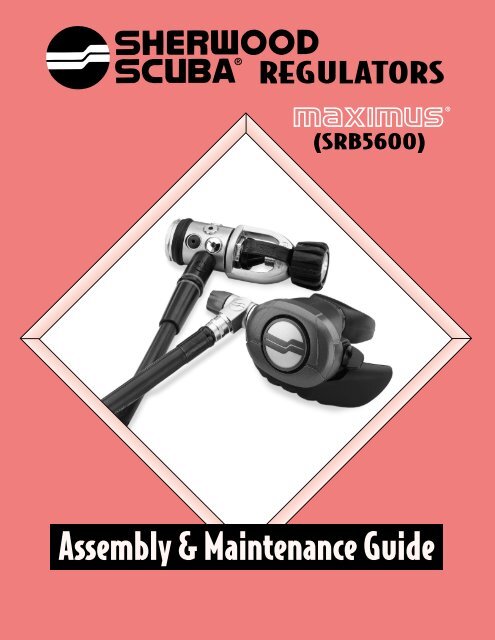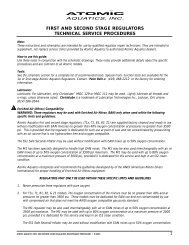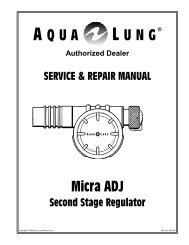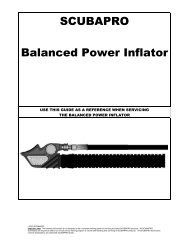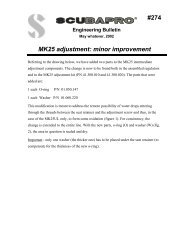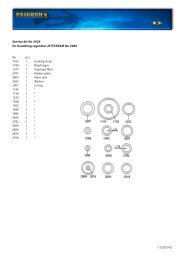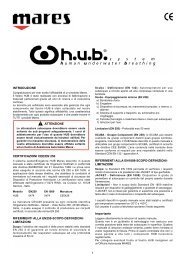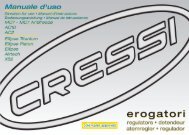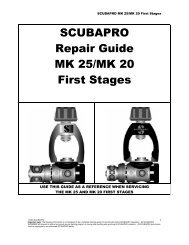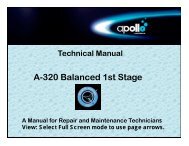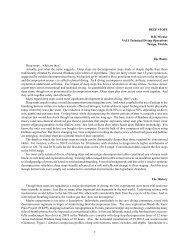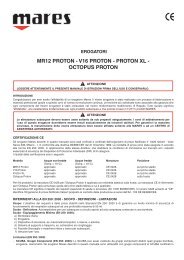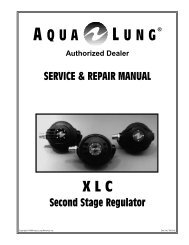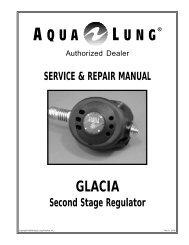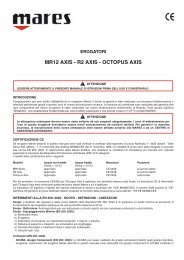SRB5600.pdf1687 KBytes - Frogkick.dk
SRB5600.pdf1687 KBytes - Frogkick.dk
SRB5600.pdf1687 KBytes - Frogkick.dk
Create successful ePaper yourself
Turn your PDF publications into a flip-book with our unique Google optimized e-Paper software.
®<br />
REGULATORS<br />
®<br />
(SRB5600)<br />
Assembly & Maintenance Guide
FIRST STAGE - MAXIMUS SRB5600<br />
The model number of the regulator is laser stamped on the first stage between two of the outlet ports.<br />
ITEM # CATALOG # DESCRIPTION<br />
1 . . . . . . . . . . .5105-70 . . . . . . . . .Handwheel<br />
2 . . . . . . .J2790056B . . . . . . . . . .Filter Retaining Ring<br />
3 . . . . . . . . . . .1390-7 . . . . . . . . .Filter<br />
4 . . . . . . . .29-5305-4 . . . . . . . . . .Moving Orifice<br />
(bare, no O-rings)<br />
5 . . . . . . . .19-8010-8 . . . . . . . . . .Belleville Spring Washers<br />
(5 needed)<br />
6 . . . . . . . . . .G007A . . . . . . . . . . .O-ring<br />
7 . . . . . . . . MS28774-007 . . . . . . .White Backup Washer<br />
8 . . . . . . . . . . .5705-20 . . . . . . . . .Dust Cap<br />
9 . . . . . . . . .1-1665-17 . . . . . . . . .Yoke Nut<br />
10 . . . . . . .70-1665-26 . . . . . . . . .Yoke<br />
11 . . . . . . . . .G904A . . . . . . . . . .O-ring (for H. P. port plug)<br />
12 . . . . . . . .1-3405-4 . . . . . . . . . .H. P. Port Plug<br />
13 . . . . . . . .70-5705-1 . . . . . . . . . .Body<br />
14 . . . . . . . . .G011B . . . . . . . . . . .O-ring (for L.P. Port Plugs)<br />
15 . . . . . . . . . .3106-6 . . . . . . . . .One Way Bleed Valve<br />
16 . . . . . . . .1-3105-6 . . . . . . . . . .L. P. Port Plug<br />
17 . . . . . . . . . .5105-6 . . . . . . . . .Gasket for Flow Control Element<br />
18 . . . . . . . . . .5105-15 . . . . . . . . .Restrictor Assembly<br />
18 . . . . . . . . . .5105-13 . . . . . . . . .Flow Restrictor Screw<br />
18 . . . . . . . . . .5105-14 . . . . . . . . .Filter<br />
19 . . . . . . . . . .5105-12 . . . . . . . . .Main Spring<br />
20 . . . . . . . . . .5105-PK . . . . . . . .Shim (to raise hose pressure)<br />
21 . . . . . . . . .G007A . . . . . . . . . . .O-ring (for small end of piston)<br />
22 . . . . . . . . . .3801-5 . . . . . . . . .Piston Seat<br />
23 . . . . . . . . . .5105-3 . . . . . . . . .Piston (bare, no seat or O-rings)<br />
24 . . . . . . . . .G022A . . . . . . . . . . .O-ring (for large end of piston)<br />
25. . . . . . . . .G025A . . . . . . . . . . .O-ring (for cap)<br />
26 . . . . . . . .70-5305-2 . . . . . . . . . .Cap<br />
27 . . . . . . . . . .5700-15 . . . . . . . . .Cap Label<br />
28 . . . . . . . . . .5705-21PE . . . . . .Trim Ring
TABLE OF CONTENTS<br />
1.0 Introduction . . . . . . . . . . . . . . . . . . . . . . . . . . . . . . . . . . . . .1<br />
2.0 Specifications . . . . . . . . . . . . . . . . . . . . . . . . . . . . . . . . . . .3<br />
2.1 SRB5600 (Maximus) . . . . . . . . . . . . . . . . . . . . . . . . . . . . . . .3<br />
3.0 O-rings Reference Chart . . . . . . . . . . . . . . . . . . . . . . . . . . .4<br />
Page<br />
4.0 First Stage Procedures . . . . . . . . . . . . . . . . . . . . . . . . . . . .5<br />
4.1 Tools Required for First Stage Servicing . . . . . . . . . . . . . . . .5<br />
4.2 Disassembly of First Stage . . . . . . . . . . . . . . . . . . . . . . . . . .5<br />
4.3 Assembly of First Stage . . . . . . . . . . . . . . . . . . . . . . . . . . . .9<br />
4.4 Testing of First Stage . . . . . . . . . . . . . . . . . . . . . . . . . . . . . . .10<br />
5.0 Second Stage Procedures . . . . . . . . . . . . . . . . . . . . . . . . .12<br />
5.1 Tools Required for Second Stage Servicing . . . . . . . . . . . . . .12<br />
5.2 Disassembly of Second Stage . . . . . . . . . . . . . . . . . . . . . . . .12<br />
5.3 Assembly of Second Stage . . . . . . . . . . . . . . . . . . . . . . . . . .14<br />
5.4 Set-Up of Second Stage . . . . . . . . . . . . . . . . . . . . . . . . . . . .16<br />
5.5 Testing of Second Stage . . . . . . . . . . . . . . . . . . . . . . . . . . . .18<br />
6.0 Helpful Hints . . . . . . . . . . . . . . . . . . . . . . . . . . . . . . . . . . . .20<br />
6.1 Troubleshooting . . . . . . . . . . . . . . . . . . . . . . . . . . . . . . . . . .20<br />
6.2 Parts Cleaning Recommendations . . . . . . . . . . . . . . . . . . . . .22<br />
6.3 Commonly Used Cleaning Solutions . . . . . . . . . . . . . . . . . . .22<br />
6.4 Handling Tips . . . . . . . . . . . . . . . . . . . . . . . . . . . . . . . . . . . .23<br />
7.0 Two Year Warranty and Maintenance Information . . . . . . .24<br />
7.1 Proper Procedure for Warranty Paperwork . . . . . . . . . . . . . .24<br />
7.2 Scheduled Maintenance . . . . . . . . . . . . . . . . . . . . . . . . . . . .24<br />
BEFORE YOU BEGIN.....<br />
READ THESE INSTRUCTIONS COMPLETELY BEFORE YOU BEGIN SERVICING THE<br />
REGULATOR.<br />
THESE INSTRUCTIONS ARE INTENDED FOR PEOPLE WHO HAVE BEEN AUTHORIZED BY<br />
SHERWOOD TO REPAIR SHERWOOD SCUBA EQUIPMENT. IF YOU ARE NOT SO<br />
AUTHORIZED - STOP.
1.0 INTRODUCTION<br />
1. The procedures in this manual apply to the Sherwood Scuba SRB5600 Maximus regulator<br />
only. The older SRB3600 Maximus regulator has different parts and service procedures. The<br />
SRB3600 has its own service manual. The correct service manual for the two models can be<br />
determined by looking at the cover picture of the regulator. The most current part numbers can<br />
be obtained by referring to the dealer price guide, or calling your Sherwood Sales<br />
Representative.<br />
WARNING<br />
Proper torque for the hose fittings is 40 in. lbs. (4.5 joules). NEVER tighten the hose fitting<br />
to the first stage with more than 45 in. lbs. (5 joules) of torque. The inlet hose fitting<br />
can be weakened by overtightening. Failure of the fitting could cause air loss resulting<br />
in death, personal injury, or property damage.<br />
All current Sherwood Scuba Regulators have service kits available which contain the parts<br />
which must be changed at every annual service no matter what their condition. The standard<br />
annual service kit for the Maximus is 4000-4. All other parts not contained in this kit must be<br />
inspected by the technician and changed under warranty only if they have failed due to<br />
problems with material or workmanship.<br />
NOTE: Oxygen Enriched Air conversion kits are available for all current Sherwood regulators and valves.<br />
The part number for the model covered in this manual is 4000-15N. These kits are to be installed into<br />
properly cleaned and prepared regulators only by technicians trained by one of the major oxygen enriched<br />
air training agencies.<br />
2. This manual gives breakdowns of regulator parts, equipment specifications, servicing<br />
instructions, troubleshooting recommendations, and guidelines for proper care of the SRB5600<br />
Maximus regulator. This manual is intended for use only by persons specially trained and<br />
authorized to service Sherwood Scuba equipment.<br />
3. Anyone attempting to service or repair Sherwood Scuba regulators must have a thorough<br />
understanding of the principles of operation of scuba regulators and valves, as well as the<br />
appropriate mechanical ability. The technician must be properly trained in the safe use of<br />
compressed air and the various tools and cleaning solutions involved in the procedures<br />
outlined in this manual.<br />
4. The best source for current part numbers for any of the parts listed in this manual is your<br />
current parts and price list from Sherwood.<br />
5. Because of the many unique features found in Sherwood regulators, Sherwood conducts<br />
seminars on a regular basis throughout North America to train technicians in proper service and<br />
repair procedures for all current Sherwood regulators. In addition, all Sherwood dealers and<br />
their staff members are encouraged to attend the seminars to gain an in-depth understanding<br />
of the construction, special features and operation of Sherwood regulators. For information on<br />
the dates and locations of upcoming Sherwood service seminars near you, contact<br />
Sherwood or your Sherwood Sales Representative.<br />
NOTE: You must be authorized by Sherwood to work on Sherwood Scuba equipment. You can obtain<br />
proper authorization by attending all appropriate seminars given in your area. This is the only way you can<br />
become an authorized Sherwood technician.<br />
1
6. Companion instructional VHS videotapes to this and other Sherwood Scuba repair manuals are<br />
available from Sherwood Scuba at a nominal cost. Ask your Sherwood Scuba Sales<br />
Representative for details.<br />
7. If you have any questions, or need more information, contact your Sherwood Scuba Sales<br />
Representative.<br />
2
2.0 SPECIFICATIONS<br />
2.1 SPECIFICATIONS FOR THE SRB5600 MAXIMUS<br />
REGULATOR MODEL:<br />
AIR FLOW:<br />
INHALATION RESISTANCE:<br />
EXHALATION RESISTANCE:<br />
RECOMMENDED LUBRICANT:<br />
Sherwood SRB5600 Maximus<br />
33 cu. ft. (935 liters)/min. @ 1 atmosphere<br />
.9" - 1.5" (2.3 - 3.8 cm) w.c @ 1 atmosphere (adjustable)<br />
0.7" (1.8 cm) w.c. max. @ 1 atm.<br />
Christo-Lube ® MCG111 (Sherwood p/n SW-MS150)<br />
A. First Stage Regulator:<br />
TYPE:<br />
Flow-by piston with Moving Orifice Balancing, Dry Air<br />
Bleed, and Air Sensing Channel Boost – U.S. Pat. #<br />
4,226,257, U.S. Pat. #5,662,100<br />
WEIGHT:<br />
1 lb. 11 oz. (.77kg)<br />
INTERSTAGE PRESSURE: 135 -150 psi (9-10 bar)<br />
MAXIMUM INLET PRESSURE: 300 bar ( with 300 bar DIN adapter )<br />
POSITIVE AIR PURGE<br />
FLOW RATE:<br />
13-27 cc/minute<br />
# LOW PRESSURE PORTS: 5 (3/8"-24 UNF)<br />
# HIGH PRESSURE PORTS: 2 (7/16"-20 UNF)<br />
MATERIALS:<br />
Body – CDA-36000 Brass<br />
O-rings – Buna-N (Viton Nitrox o-ring kit available)<br />
Bleed Valve – Ethylene Propylene<br />
Piston Seat – Teflon ®<br />
B. Second Stage Regulator:<br />
TYPE: Downstream valve, diaphragm, Variable Fulcrum –<br />
U.S. Pat.#3,991,785 other Pat. pending<br />
WEIGHT:<br />
7.1 oz. (.22 kg) ( w/o hose)<br />
HOSE LENGTH: 41 in. (1.04 m)<br />
MATERIALS :<br />
Cover –Thermoplastic vinyl<br />
Case –Thermoplastic Triax ®<br />
Poppet Seat – Buna-N<br />
O-Rings – Buna-N<br />
Diaphragm – Tufel ® (clear blue)<br />
Exhaust Valve – Thermoplastic elastomer (blue)<br />
Mouthpiece – Liquid Silicone<br />
3
3.0 O-RINGS REFERENCE CHART<br />
1. Before you begin disassembly of the regulator, test the first and second stages for output<br />
pressures and leakage. Pre-testing in this way will help the technician to pinpoint any specific<br />
problems requiring repair.<br />
2. The work area must be clean and well lighted, with clean compressed air available to blow<br />
sand and dirt from parts.<br />
4
4.0 FIRST STAGE PROCEDURES<br />
4.1 TOOLS REQUIRED FOR FIRST STAGE SERVICING<br />
– Bench vise<br />
– 3/32" Allen wrench<br />
– 5/32" Allen wrench<br />
– 6" or 8" adjustable wrenches<br />
– 15" adjustable wrench<br />
– Phillips screwdriver<br />
– #10 Torx screwdriver<br />
– Sherwood 50 cc Graduated Cylinder (p/n TL110)<br />
– Sherwood Piston Seat Removal Tool (p/n TL112)<br />
– Sherwood Plastic Probe (p/n TL111) to push out orifice<br />
– Sherwood Regulator Support Handle (p/n TL113)<br />
– Sherwood Intermediate Pressure Gauge (p/n TL119)<br />
– Annual Service Kit #4000-4 (same as older style Maximus)<br />
– Nitrox Conversion Kit #4000-4N<br />
– Christo-Lube ® (p/n SW-MS150), 2 oz. tube of oxygen compatible lubricant<br />
NOTE: For more information on Sherwood tools and their uses, see Sherwood’s Tools, Repair Kits and<br />
Accessories - Assembly & Maintenance Guide, available from Sherwood.<br />
4.2 DISASSEMBLY OF FIRST STAGE<br />
To view all the parts used in the first stage, fold out the front cover of this manual. The<br />
circled numbers below refer to the corresponding numbers on the drawing.<br />
1. Use 6" or 8" adjustable wrenches to disconnect all hoses from the first stage. Pull back the<br />
hose protector from the inlet end of the hose. Inspect the hoses for wear. Pay particular attention<br />
to the area where the metal ferrules meet the rubber hose material. Replace hoses if necessary.<br />
2. Unscrew and remove the handwheel 1 .<br />
3. Remove the dust cap 8 .<br />
5
4. Install a Sherwood regulator support handle (p/n TL113) into one of the low-pressure ports. Use<br />
the support handle and a 15" adjustable wrench or bench vise to loosen the yoke nut 9 from<br />
the body 13 . See Photo #1.<br />
Photo #1<br />
5. Remove the yoke 10 and yoke nut 9 from the body.<br />
6. Use a 5/32" Allen wrench to remove all remaining port plugs 12 16 from the body.<br />
7. Use the Sherwood regulator support handle and a 15" adjustable wrench or a bench vise to<br />
remove the cap 26 from the main body. The trim ring 28 will slide off at this time.<br />
8. Remove the spring 19 , any shims 20 , and the piston assembly 23 from the cap. Remove<br />
both piston O-rings and discard them.<br />
9. Remove the piston seat 22 by pushing through the stem with the Sherwood piston seat<br />
removal tool (p/n TL112) from the large end. The seat will then pop out. Discard the old seat.<br />
10. Using a 3/32" Allen wrench, remove the flow control element assembly 18 from inside the large<br />
end of the main body. There are two styles of flow control assemblies. The old style with a<br />
sintered stainless steel flow restrictor and the new style flow restrictor that is laser drilled P/N<br />
5105-13 with a white filter P/N 5105-14. The new style complete assembly part number is<br />
5105-15. If the regulator has the old style flow restrictor and it is functioning (13 to 27 cc/min) it<br />
can be reused, however if it needs to be replaced use the new style. The black gasket can be<br />
reused. The new style restrictor can be cleaned if it becomes plugged. Remove the white filter<br />
and discard it. The white filter must be replaced P/N 5105-14. The laser drilled flow restrictor<br />
can be cleaned in an ultrasonic cleaner and reused. The flow requirement for the new flow<br />
control assembly is 20 to 30 cc/min.<br />
6
Photo #2<br />
Note:<br />
If no air is bubbling from the one-way bleed valve, this is a good indication that the<br />
positive air purge system is not working.<br />
11. Use a pocket screw driver to remove the black washer 17 that was beneath the element<br />
assembly. Save this washer as it can usually be reused. Be careful not to scratch the metal<br />
surface under the washer.<br />
12. Use a pocket screwdriver to remove the retaining ring or star washer 2 that holds the inlet<br />
filter 3 in place. Always discard the used inlet filter. The retaining ring is saved for reuse.<br />
13. Remove the moving orifice assembly 4 from the body by pushing it with the Sherwood plastic<br />
probe (p/n TL111) from the large threaded end of the body. Catch the orifice assembly in your<br />
hand as it comes out the yoke nut thread end of the body. Carefully inspect the disc springs 5<br />
for any cracks. Replace all five disc springs if any cracks are found.<br />
14. Remove the one way bleed valve 15 from the body with your fingers or a soft plastic probe.<br />
DO NOT use a metal screwdriver or blade since this will scratch the sealing surface against<br />
which the bleed valve seals. A scratch may allow water to enter the first stage spring chamber<br />
during use.<br />
7
The sealing surface on the body where the one-way valve seals must be totally clean of<br />
deposits. If any deposits remain on the sealing surface after initial cleaning, take a fine abrasive<br />
polishing stick or and polish the surface to remove deposits (see Photo #3).<br />
Photo #3<br />
15. Blow all residue from the body after polishing.<br />
16. Remove the large O-ring 25 from the cap 26 . This O-ring can usually be reused.<br />
17. If necessary, clean all metal parts of the first stage except the flow control element assembly<br />
18 in an ultrasonic cleaner or cleaning solution. Remove the O-rings before cleaning any metal<br />
parts; most cleaning solutions can damage the O-ring material. See Section 6.3 for<br />
recommendations on cleaning solutions. If major visible corrosion or deposits exist on parts,<br />
use a bristle brush, wooden, or plastic stick to rub the deposits off. Allowing acidic cleaning<br />
solutions to do all of the work if deposits are severe, will result in damage to internal chrome<br />
plating which will make parts even more susceptible to future corrosion.<br />
18. Remove the regulator parts from the cleaning solution. Blow all internal passageways dry with<br />
clean, dry compressed air.<br />
19. Inspect the bores in which the piston and orifice O-rings move for corrosion or wear. If the<br />
bores are leaking air because of wear, replace the parts. If some corrosion deposits persist,<br />
carefully wipe them away with a plastic scrubbing cloth. Blow any resulting dust out of the<br />
regulator parts.<br />
20. Remove and discard the black O-ring from the moving orifice 4 . Save the white backup<br />
washer; it can be reused. Inspect the moving orifice’s sealing surface (located at the top edge<br />
of the orifice cone). Any nicks, scratches, or corrosion at the top of the cone can allow air to<br />
pass, which will result in creeping hose pressures. Polish out the defects using a fine abrasive<br />
polishing stick or pencil eraser. When polishing, apply a light pressure to prevent excessive<br />
wear on the cone. Use compressed air to blow away any dust created by the polishing<br />
process.<br />
8
4.3 ASSEMBLY OF FIRST STAGE<br />
1. The part number for each regulator kit can be found in Sherwood’s Tools, Repair Kit and<br />
Accessories – Assembly & Maintenance Guide. The kits contain the parts that are always<br />
replaced at every annual service interval. The kit number for the Maximus is 4000-4. For Nitrox<br />
use, the kit # is 4000-4N.<br />
2. Before installing new O-rings on the piston and moving orifice, lubricate the O-rings with<br />
Christo-Lube MCG111 (Sherwood p/n SW-MS150). Installation of the small O-ring 21 on the<br />
piston is made much easier by using the white-colored Sherwood O-ring installation cone (p/n<br />
TL109). Place the cone over the tip of the piston. Slide the lubricated O-ring over the cone until<br />
it slips into the piston groove.<br />
3. Place the new piston seat on a clean piece of paper on a hard flat surface. Press the piston tip<br />
firmly over the seat until it is fully installed. The piston is now rebuilt and ready for installation.<br />
4. Use the Sherwood installation cone to prevent damage to the new O-ring during installation<br />
onto the moving orifice. Use the green O-ring installation cone (p/n 28-TL107) to install first the<br />
new O-ring 6 and then the used backup washer 7 onto the groove on the moving orifice.<br />
Position them so that the black O-ring is closest to the wide end of the moving orifice.<br />
5. Using a greased soft probe, lightly lubricate the first 1/8" of the small bore in the body<br />
where the small piston and moving orifice O-rings seal.<br />
13<br />
6. With your finger, push the moving orifice assembly, pointed orifice end first, into the yoke end<br />
of the main body as far as possible. Place the inlet filter 3 , rough side up, on top of the<br />
moving orifice. Place the retaining ring or star washer 2 on top of the filter. Push the retaining<br />
ring or star washer firmly into place with a dowel or screwdriver.<br />
7. Install the used black washer 17 into the hole in the main body where the flow element is<br />
placed. A new washer may be installed if necessary.<br />
8. Install the flow control element 18 into the main body. Tighten the element with a 3/32" Allen<br />
wrench with a torque of 3 in. lbs. (.4 nm). Do not overtighten.<br />
9. Replace the cleaned and lightly lubricated O-ring 25 on the cap 26 .<br />
10. Install the piston assembly 23 squarely into the cap 26 . If any shims were found when the<br />
regulator was disassembled, place them over the piston stem. Then place the main spring 19<br />
over the piston stem. Install the trim ring 28 onto the body.<br />
11. Install the cap assembly onto the body. Hand-tighten the assembly as tightly as possible, then<br />
install the Sherwood regulator support handle into one of the low pressure ports. Using a 15"<br />
adjustable wrench or a bench vice to hold the cap, tighten the cap onto the body until it<br />
bottoms on the thread. Do not tighten further.<br />
12. Using your index finger, install the clean and dry one-way bleed valve 15 into the body.<br />
NOTE: If you use the bleed valve with the Sherwood logo molded into it P/N 3106-6 you will notice a<br />
"dot" molded near the right side of the logo. Install the bleed valve with the "dot" oriented closest to the<br />
inlet of the regulator (towards the yoke).<br />
13. Lightly lubricate the body yoke nut threads with grease, and install the yoke 10 and the yoke<br />
nut 9 onto the body.<br />
9
14. Using the regulator support handle (p/n TL113) in one of the LP pressure ports of the body and<br />
a 15" adjustable wrench, tighten the yoke nut snugly (see Photo #1).<br />
15. Install the handwheel 1 and the dust cap 8 onto the yoke.<br />
16. If the first stage has a SAA-5300 DIN adapter installed instead of a standard yoke, see the<br />
installation instructions given in Sherwood Technical Bulletin #104 for overhaul and installation<br />
instructions of the DIN adapter.<br />
4.4 TESTING OF FIRST STAGE<br />
NOTE: For safety, always test the first stage regulator with at least one second stage installed.The<br />
demand valve on the second stage acts as a relief valve in the event of a malfunction.<br />
A. Before You Begin Testing<br />
1. Install an intermediate pressure test gauge (p/n TL119) into one of the low pressure ports of the<br />
first stage. Plug any open outlet ports with suitable port plugs.<br />
2. Install the first stage onto a tank valve, and introduce 2700 - 3500 psig (186-240 bar) to the<br />
inlet of the regulator. Flow air through the regulator by pushing the purge button on the second<br />
stage several times to get all parts properly seated.<br />
B. Dry Air Bleed Flow Test<br />
1. Submerge the first stage under several inches of water.<br />
2. A small stream of bubbles should be escaping from the one-way bleed valve on the first stage<br />
and nowhere else on the body (see Fig. 1). The number and size of the bubbles may vary from<br />
regulator to regulator. To check this, use the following steps:<br />
a. Invert a small (50 cc capacity) graduated cylinder (p/n TL110) filled with water over the<br />
underwater flow of bubbles (see Fig. 1). The air entering the cylinder will gradually empty<br />
some of the water out of the cylinder.<br />
b. After one minute, remove the graduated cylinder from the air flow and raise the cylinder to<br />
the surface so that air/water dividing line inside the cylinder matches the water level outside<br />
the cylinder. The measurement at this point should be between 13 and 27 cc for the old<br />
style flow control element and 20-30 cc for the new laser drilled flow control element.<br />
c. If the reading is significantly higher than 30cc check the O-rings and sealing surfacesmated<br />
to the piston. If the reading is below 13cc, check the flow control element 18 to determine if<br />
it has been clogged by grease or other foreign matter. If it is clogged, it must be replaced<br />
(old style sintered stainless steel ) or cleaned (new laser drilled element).<br />
10
C. Intermediate Pressure Test<br />
NOTE: This test determines the regulator’s lock-up pressure (the pressure put out by the first stage during<br />
a no-flow condition).<br />
1. Attach any Sherwood second stage to one of the low pressure ports, and the Sherwood<br />
intermediate pressure gauge (p/n TL119) to another low pressure port. Plug all other ports with<br />
appropriate port plugs.<br />
2. Attach the regulator to a tank valve giving a source pressure of between 2700 and 3500 psig<br />
(186 and 240 bar).<br />
3. Turn the supply air on slowly while listening for any unusual air leaks. If any are heard, turn<br />
the air off immediately and determine the source of the leak. If no leaks are found, watch the<br />
pressure gauge reading rise as you continue turning the air on slowly. It should stop around<br />
145 psig (10 bar).<br />
4. If the pressure gauge continues to rise above 155 psig (10.4 bar), turn the air supply off<br />
immediately and inspect the regulator to determine the cause.<br />
5. Once the air pressure stops rising, the internal parts should be worked into place by allowing<br />
air to escape from the second stage several times by pushing the purge button.<br />
6. If you have depressed the purge button several times and the pressure is below 135 psig (9.3<br />
bar), you can add shims 20 to increase the pressure. Do not use more than three shims.<br />
7. If the pressure is too high (above 150 psig or 10.3 bar), remove the necessary shims.<br />
8. After the correct pressure has been reached, let the regulator sit for several minutes and then<br />
depress the purge button again to check that the regulator returns to the proper pressure.<br />
Never set the output pressure of the first stage above 150 psig (10.3 bar).<br />
11
5.0 SECOND STAGE PROCEDURES<br />
5.1 TOOLS REQUIRED FOR SECOND STAGE SERVICING<br />
– Two good quality 6" or 8" (15 or 20 cm) adjustable wrenches<br />
– #10 Torx screwdriver<br />
– Side cutting pliers<br />
– Sherwood Plastic Probe (p/n TL111) to push out orifice<br />
– Sherwood Lever Height Adjusting Tool (p/n TL123)<br />
– Small Phillips screwdriver<br />
– Small slotted screwdriver<br />
– Size "0" square drive screwdriver (e.g. Channel Lock p/n SL-0)<br />
– Locktite 242 ® (mild thread locking adhesive)<br />
– Christo-Lube ® (p/n SW-MS150), 2 oz. tube of oxygen compatible lubricant<br />
5.2 DISASSEMBLY OF SECOND STAGE<br />
WARNING<br />
Proper torque for the hose fittings is 40 in. lbs. (4.5 Joules). NEVER tighten the hose<br />
fitting to the first stage with more than 45 in. lbs. (5 Joules) of torque. The inlet hose<br />
fitting can be weakened by overtightening. Failure of the fitting could cause air loss<br />
resulting in death, personal injury or property damage.<br />
To view the complete parts list of the second stage, fold out the back cover of this manual.<br />
1. Remove the hose assembly 3 from the swivel fitting 10 . Inspect the hose assembly for<br />
any cuts or cracks, especially on the hose at the metal ferrules. Replace the hose assembly if<br />
any cuts or cracks are found.<br />
2. Remove the mouthpiece 22 by cutting the mouthpiece tie 21 with side cutting pliers. Discard<br />
the old mouthpiece tie. Examine the condition of the mouthpiece. Pay particular attention to<br />
the area on top just behind where the old tie tightened. This is a prime area for small holes to<br />
develop. If the mouthpiece is in good condition, it can be reused.<br />
3. Remove the exhaust tee retaining screws 28 with a #10 Torx or slotted screwdriver.<br />
4. Remove the exhaust tee 38 from the case by pulling it back and off the top edge.<br />
5. Using a size 0 Square Drive Screwdriver (preferred) or a small Phillips Screwdriver, loosen and<br />
remove the screw 5 and washer 6 from the orifice Adjusting Knob 7 .<br />
6. Remove the adjusting knob from the end of the adjusting orifice.<br />
12
7. Using a small slotted screwdriver, remove the cir-clip 4 from the adjusting orifice 16 .<br />
8. Use a 5/8" wrench to remove the retainer nut 9 from the orifice housing 13 . Hold the base of<br />
the orifice housing with a 3/4" wrench while doing this.<br />
9. Remove the swivel fitting 10 from the orifice housing. Inspect the inner sealing surfaces for<br />
scratches that might cause leaks.<br />
10. Remove the cover 17 from the case by pushing on the front top edge firmly enough to cause<br />
the top lip of the cover to curl outwards. Use fingers to grasp the exposed lip of the cover.<br />
Slide the cover assemble off of the orifice housing.<br />
11. Remove the diaphragm retaining ring 18 from the case using fingers.<br />
12. Gently remove the diaphragm 19 from the case. Hold the diaphragm up to a light source.<br />
Gently stretch the diaphragm and look for tears or pinholes. If any are found, replace the<br />
diaphragm. Otherwise, the diaphragm can be reused. If you are repeatedly tearing diaphragms<br />
during this visual inspection, you are using too much force. You cannot return diaphragms torn<br />
in this way for warranty credit.<br />
13. Remove the adjusting lever 25 from the case by using a small slotted screwdriver to slide the<br />
retainer clip 23 , off the adjusting lever. Slide the adjusting lever out of the case 20 . The<br />
adjusting lever and o-ring 24 can usually be cleaned by hand in warm soapy water,<br />
relubricated, and reused with the o-ring in place. However, if the o-ring 24 shows excessive<br />
wear it can be removed and discarded at this time. Use a blunted dental pick or similar object<br />
to remove the o-ring if removal is necessary. Take care not to gouge the o-ring groove during<br />
this procedure.<br />
14. Use a 6" or 8" (15 or 20 cm) adjustable wrench to loosen and remove the orifice housing 13 .<br />
The case assembly has been reinforced to allow doing this without holding the lever support<br />
with another wrench.<br />
15. Remove the lever support 32 and assembly from the case with the heat transfer fins 34 & 35<br />
still attached. There is no reason to remove these fins from the lever support during a normal<br />
service interval. If the fins do have to be removed for some reason, a small Phillips ACR<br />
screwdriver can be used to remove and replace the screws 28 .<br />
16. Normally, along with cleaning, you will simply need to change the poppet stem seat insert 29<br />
and polish the orifice seal 16 , to restore the second stage to maximum performance. To<br />
change the stem seat insert 29 , leave the lever assembly together. With a pick or similar<br />
object, carefully remove the old seat insert. Put the new seat insert on a clean flat surface and<br />
lower the poppet cavity (from which the old seat insert was removed) over the new seat insert.<br />
The new style black molded seat (p/n 978-9BN) should be installed with the identifying<br />
Sherwood symbol facing outward.<br />
17. If parts of the lever assembly (stem, spring, lever, etc.) need to be replaced, it can be done with<br />
a minimum number of tools. With the original poppet seat 29 in place, and the orifice 16<br />
installed in the orifice housing 13 , screw the orifice housing and lever support together<br />
(without the case) until the lever begins to droop. Use a #10 Torx screwdriver to remove the<br />
screw 37 . Unscrew the orifice housing and lever support, and the poppet and spring will be<br />
exposed for replacement. Reverse the procedure to install the new parts. Remember to use the<br />
old seat to perform this procedure since the seat is likely to be damaged due to excess friction.<br />
Install a new seat 29 when you have reassembled the lever assembly.<br />
13
NOTE: If only the lever 36 is to be replaced, do not totally remove the screw. You can remove the lever<br />
from under the screw 37 when the screw is almost all the way out.<br />
18. Hold the orifice housing 13 in one hand. Temporarily install the adjuster knob 7 and use it to<br />
turn the orifice clockwise until it comes out of the orifice housing. Remove and discard the<br />
o-rings on the orifice 14 & 15 , and the orifice housing 11 & 12 .<br />
19. Before removing the exhaust valve 26 from the case, bend it over as far as it will go from the<br />
top, bottom, left and right sides. If it fails to snap back quickly, and does not lie perfectly flat<br />
against the case, the valve should be replaced. If it does snap back satisfactorily, remove it and<br />
inspect the sealing edges. If they appear smooth, and the locking tab on the nipple is good, the<br />
valve can be reused.<br />
20. Rinse all plastic and silicone parts in clean fresh water, and then blow the parts dry with<br />
compressed air to remove any sand and dust particles.<br />
21. If necessary, clean all metal parts of the second stage in an ultrasonic cleaner or cleaning<br />
solution. Remove the o-rings before cleaning any metal parts; most cleaning solutions are<br />
damaging to the o-ring material. See Section 6.3 for recommendations on cleaning solutions.<br />
NOTE: If you use an ultrasonic cleaner to clean the second stage adjustable orifice 16 , use a plastic<br />
container to prevent the orifice from vibrating against other metal parts which could damage the orifice seal.<br />
22. Inspect the case 20 for any cracks. Look particularly closely at the area where the orifice<br />
housing and the lever support clamp down. Replace the case if any cracks are found.<br />
23. Inspect the sealing surface on the orifice 16 (where the poppet insert seals) for any nicks,<br />
scratches, or corrosion. Corrosion or minor scratches can be polished out using a fine-grit<br />
rubberized polishing stick or a clean new pencil eraser. Do not apply heavy pressure when<br />
rotating the polishing stick. Stop polishing immediately after the corrosion or scratch<br />
disappears. An orifice will not be accepted for warranty replacement simply because it is dirty<br />
or corroded. The technician must clean the orifice sealing surface at every service interval.<br />
24. Blow all dust and debris out of the orifice housing with clean compressed air.<br />
NOTE: Prior to this point, you should have cleaned and inspected all parts, following proper servicing<br />
procedures. Do not continue until this has been done.<br />
5.3 ASSEMBLY OF SECOND STAGE<br />
1. Install the exhaust valve 14 into the case by inserting the nipples into the small holes from the<br />
outside of the case. Reach inside the case and pull the nipple firmly with the fingers until you<br />
hear or feel it “click” into place. Inspect the exhaust valve to see that it is properly seated.<br />
2. Install the lever support 32 and assembly into the case, setting it firmly between the guide ribs<br />
in the Case.<br />
3. Lubricate and install new o-rings 14 & 15 from the annual service kit onto the orifice 16 . Install<br />
the orifice back into the orifice housing 13 using the fingertip. Use the adjustor knob to turn the<br />
orifice counter-clockwise fully, until it stops.<br />
14
4. Screw the orifice housing 13 onto the threads of the lever assembly. Using a 3/4" wrench on<br />
the orifice housing tighten them together snugly (70 in. lbs., 7.8nm).<br />
NOTE: A drop of mild thread locker, such as Locktite 242® or equivalent should be applied to the threads<br />
of the lever support to prevent the Orifice Housing from loosening during use.<br />
5. Lubricate and install new o-rings 11 & 12 from the annual service kit onto the orifice housing<br />
Note that the larger of the two o-rings goes on the end of the housing closest to the case.<br />
6. Install the cover 17 onto the case by sliding the retaining loop over the orifice housing. Since<br />
the inner parts of the case have not yet been installed, the cover is rotated on the orifice<br />
housing out of the way at this time.<br />
7. Lightly lubricate the inner bore of the swivel fitting with the recommended grease. Install the<br />
swivel fitting onto the orifice housing.<br />
8. Install the retainer nut 9 onto the orifice housing thread. Tighten the retainer nut snugly.<br />
(70 in. lbs., 7.8 nm)<br />
9. Install the cir-clip 8 onto the orifice.<br />
10. Install the adjusting knob 7 onto the orifice.<br />
11. Install the washer 6 onto the screw 5 . Place a small drop of locking adhesive onto the<br />
threads of the screw, and install it snugly into the orifice using a size 0 square drive or Phillips<br />
screwdriver.<br />
NOTE: Do not allow lubrication (grease on fingers, silicone overspray, etc.) to get on the case 20 , the<br />
diaphragm 19 , the retaining ring 18 , or the exhaust valve 26 . This may cause these parts to slip or<br />
deteriorate.<br />
12. If the old o-ring 24 on the adjusting lever 25 was replaced due to wear, lubricate and install a<br />
new one onto the adjusting lever. If the o-ring is not worn, in can be lubricated in place on the<br />
adjusting lever. Install the adjusting lever into the case 20 . Using a small slotted screwdriver,<br />
install the retainer clip 23 onto the adjusting lever in its groove inside the case. Move the<br />
adjusting lever through its full range. Check that the fins 34 & 35 move freely in the mouthtube<br />
area. If they touch the top or bottom of the mouthtube and hang-up, rotate the lever support 32<br />
slightly until the fins move freely. If the fins do not follow the adjusting lever tip through the<br />
entire stroke, rebend the fins slightly to create the proper tension to keep them against the<br />
lever tip.<br />
THE FOLLOWING STEPS (13-19) ARE INCLUDED HERE FOR CONTINUITY. THEY MUST BE<br />
PERFORMED AFTER THE REGULATOR SECOND STAGE IS ADJUSTED (see Section 5.4, Set-Up of<br />
Second Stage).<br />
13. Install the diaphragm 19 into the case so that it sits evenly on the ledge.<br />
14. Install the retaining ring 18 into the diaphragm recess.<br />
15. Work the cover 17 over the case until it sits properly in its groove in the cover.<br />
15
16. Install the exhaust tee 38 onto the case using the two screws 28 .<br />
NOTE: Depending on the owner’s needs, either the Blizzard, Oasis and Maximus style extended tee 38 for<br />
maximum bubble dispersion, or the Magnum/Brut style shorter tee 27 for minimum weight and drag, can<br />
be installed on any of the three models.<br />
17. Tighten the exhaust tee screws 28 using a # 10 Torx screw driver just enough to seat them<br />
snugly. There is no reason to turn these screws beyond the first contact point. Do not<br />
overtighten. These screws are threaded into plastic, which will hold well in service but is easily<br />
stripped if overtightened.<br />
18. Install the mouthpiece 22 . Be sure to position the mouthpiece so that the word “Sherwood” is<br />
on the top.<br />
19. Install a new mouthpiece tie 21 . For diver’s comfort, be sure the clamp is on the side, not the<br />
top or bottom.<br />
20. Install the hose 3 into a serviced first stage, and the second stage, tighten snugly.<br />
WARNING<br />
Proper torque for the hose fittings is 40 in. lbs. (4.5 Joules). NEVER tighten the hose<br />
fitting to the first stage with more than 45 in. lbs. (5 Joules) of torque. The inlet hose fitting<br />
can be weakened by overtightening. Failure of the fitting could cause air loss resulting<br />
in death, personal injury or property damage.<br />
5.4 SET- UP OF SECOND STAGE<br />
For the following adjustments, remove the cover and diaphragm.<br />
1. Turn the adjuster knob 7 out counter-clockwise all the way.<br />
2. Use a # 10 Torx screwdriver to turn the poppet screw 37 counter-clockwise outward, until the<br />
lever assembly 32 & 36 is just loose enough so that the tip of the lever will move loosely up<br />
and down about 1/16”.<br />
3. Attach the second stage to the overhauled and properly adjusted first stage that it is going to<br />
be used with, mounted on a air tank filled to between 2700 and 3500 psig. Install an<br />
intermediate pressure gauge into one of the low pressure ports.<br />
4. Carefully turn the air on. With the lever 36 slightly loose against the lever support 32 , there<br />
should be no air leaking from the second stage with proper intermediate pressure applied to<br />
the hose. If there is air leaking from anywhere on the second stage, correct the problem before<br />
going further.<br />
5. With the air turned on, use a #10 Torx screwdriver to turn the poppet screw 37 clockwise until<br />
a slight hiss is heard coming from the second stage. Work the lever up and down a few times<br />
to ensure that the slight hiss still exists when the lever is released This adjustment has just<br />
lifted the poppet seat off the orifice seal area. This is the long term storage position (one week<br />
or longer) for the adjustment knob 7 .<br />
6. Turn the knob 7 slowly clockwise. The hissing should stop by the time the knob is turned 1/8<br />
to 1/4 of a turn clockwise. If the hissing does not stop by the time the knob has been turned<br />
1/4 of a rotation clockwise, then inspect the orifice sealing area 16 and seat 29 for damage.<br />
16
7. If the hissing has stopped properly, continue turning the knob 7 clockwise until the stop is<br />
felt. Breathe on the regulator. It should breathe fairly hard at this setting, but still deliver a good<br />
air supply.<br />
8. Check the purge button for proper operation.<br />
9. After setting the poppet screw 37 and orifice 16 , the relationship between the diaphragm wear<br />
plate and the tip of the lever 36 must be checked. To do this, install the diaphragm and<br />
retaining ring. The tip of the lever should just barely touch the diaphragm. If when touching the<br />
diaphragm lightly with the finger there seems to be a significant gap between the lever tip and<br />
diaphragm, remove the diaphragm and bend the lever slightly upwards using the fingers. If the<br />
regulator hisses slightly when the air is turned on, but stops hissing when the diaphragm is<br />
removed, then the lever is too high. Use Sherwood’s lever bending tool (p/n 4005-16) to bend<br />
the lever slightly downward as shown in Photo #5. There are two indentations at the proper<br />
lever bend point.<br />
Photo #5<br />
10. Replace the diaphragm and test the gap between the lever and the diaphragm again after each<br />
bending. Lever bending is usually necessary only when a new lever is being installed in the<br />
regulator. If you are re-using the same major parts of the regulator, this measurement will most<br />
likely be correct, and no adjustment will be needed. In fact bending the lever should be avoided<br />
unless necessary to get the tip of the lever in the proper position.<br />
11. Replace the cover 17 .<br />
12. Return to Section 5.3.13 of this manual to complete assembly of the regulator.<br />
17
5.5 TESTING OF SECOND STAGE<br />
A. Inhalation Effort<br />
1. If you have no instrumentation, breathe on the regulator to test the breathing effort. With the<br />
adjusting knob turned fully counter-clockwise a slight hissing free flow should be heard. The<br />
hissing should stop when the knob is turned slightly clockwise. The breathing should be easy<br />
at this point. Turn the knob fully clockwise. The inhalation should be more difficult, but the<br />
purge button should still work.<br />
2. If a water column or water manometer is used to check inhalation effort, it should not exceed<br />
1" w. c. at cracking with the adjustor knob in the minimum effort position. It should drop to<br />
about 3/4" w. c. at one atmosphere and a moderate flow rate. The technician can alter the<br />
inhalation effort within a certain range. The overall inhalation effort can be decreased by turning<br />
the poppet screw 37 counterclockwise, and adjusting the intermediate pressure to the top end<br />
of the range. However, counterclockwise adjusting must stop when the lever 36 becomes loose<br />
against the lever support 32 . The overall inhalation effort can be increased by turning the<br />
poppet screw 37 clockwise, and adjusting the intermediate pressure to the lower part of the<br />
range. However, clockwise adjusting must stop when air begins to hiss past the second stage<br />
Poppet. Note: This higher effort setting also gives the regulator its greatest resistance to<br />
second stage freeze-ups in cold water diving.<br />
3. Move the venturi adjusting lever 25 through its full range of movement while inhaling on the<br />
regulator. With surface air flows you will only be able to feel the air moving from a left to right<br />
jetting in the mouth. At greater depths, the volume of air will increase to the point where<br />
adjusting the lever to the “+” position (as indicated on the case) will cause a marked increase in<br />
the venturi effect and subsequent air delivery.<br />
B. Exhalation Effort<br />
1. If you do not use instruments to check the exhalation effort, the flow should feel smooth and<br />
unrestricted.<br />
2. If you use a water column, it should not exceed 1/2" w.c. (.02 bar) at one atmosphere.<br />
3. Brand new exhaust valves will sometimes adhere slightly to the case, causing a slight increase<br />
in inhalation effort. This condition will disappear with use.<br />
C. Leak Test<br />
1. Disconnect the air supply. Purge the regulator of all positive air pressure.<br />
2. Slowly immerse the second stage in a pan of water with the mouthpiece pointing straight up.<br />
3. Immerse the regulator until the water is 1/4" to 1/8" (.64 to .32 cm) from the lip of the<br />
mouthpiece.<br />
4. Hold the regulator in this position for one minute and then slowly raise it out of the water.<br />
5. Tip the regulator mouthpiece downward and watch the inside of the mouthpiece tube. If any<br />
water escapes from the mouthpiece tube, check for source of leakage.<br />
18
D. Intermediate Pressure Air Leaks<br />
1. Attach the regulator first stage to a tank short enough to totally submerge the first and second<br />
stage in your filling station cooling water. Adjust the breathing effort knob to the minimum<br />
breathing effort position (not the slight freeflow position).<br />
2. With the tank valve still turned off, flood the second stage completely with water, and then<br />
position it mouthpiece up.<br />
3. Turn the tank air valve on slowly and then watch for any leaks in the first or second stage<br />
(except for the normal flow of air from the one-way bleed valve on the first stage).<br />
4. Repair any leaks.<br />
5. Check for the correct positive air purge flow rate. See Section 4.4, “Testing of First Stage,”<br />
for the proper method.<br />
19
6.0 HELPFUL HINTS<br />
6.1 TROUBLESHOOTING REGULATORS<br />
POSSIBLE CAUSE<br />
RECOMMENDED ACTION<br />
A. High Inhalation Effort at Depth:<br />
1. Inlet filter clogged. Replace the filter.<br />
2. No air flowing through the dry air bleed system. Check the flow rate coming out of the<br />
one-way bleed valve 15 . If no or low<br />
air flow is detected, replace the flow<br />
element assembly 18 .<br />
3. Air supply to first stage insufficient. Verify the supply air pressure. Make<br />
sure the customer had the air valve<br />
turned all the way on during the dive.<br />
4. Second stage improperly adjusted. Repeat Steps 1 through 6 in Section<br />
5.4, Set-Up of Second Stage.<br />
B. Free Flowing:<br />
1. Intermediate pressure too high. Adjust intermediate pressure below<br />
150 psi by removing shims 20 .<br />
2. Damaged or worn first stage piston seat. Replace piston seat 22 .<br />
3. Damaged or worn second stage poppet seat. Replace second stage poppet seat 29 .<br />
4. Nicked or corroded orifice sealing surfaces. Polish the orifice sealing surfaces in<br />
both the first and second stages with a<br />
pencil eraser or polishing stick. If<br />
damage is too severe to polish out,<br />
replace orifice 4 or 16 .<br />
5. Second stage demand lever bent too high. Adjust or replace the lever.<br />
6. Weak spring in second stage. Replace the spring.<br />
7. First or second stage improperly adjusted. Refer to Sections 4.4 and 5.4 of this<br />
manual.<br />
8. Parts in the second stage have been severely Allow the second stage to warm back<br />
chilled due to repeated purging and have shrunk, up to room temperature. This chilling<br />
allowing air to flow.<br />
will not occur in normal diving.<br />
20
C. Wet Breathing:<br />
1. Improper clearing, or diver diving in total Instruct the diver on proper clearing<br />
head-down position.<br />
technique.<br />
2. Leaking past adjusting lever 25 . Install new o-ring 24 . Check sealing<br />
surface & groove.<br />
3. Diaphragm improperly installed or holed. Check position of diaphragm visually.<br />
Replace if holed.<br />
4. Damaged or loose fitting exhaust valve Replace exhaust valve 26 .<br />
5. Crack in case 20 . Replace case.<br />
D. High Frequency Humming or Buzzing During Inhalation:<br />
1. Harmonic resonance between the springs Disassemble the first stage and flip the<br />
and the mass of the piston in the first stage. main spring over. Change the position<br />
of the piston 23 in its bore. If<br />
resonance is still present, install a new<br />
piston and spring.<br />
E. Low Frequency Fluttering During Inhalation (Above the Surface Only):<br />
1. Harmonic resonance between the springs Try adjusting the lever tip closer or<br />
and the mass of the second stage diaphragm. farther from the diaphragm wear plate.<br />
Switch diaphragm with another unit.<br />
Explain to the customer that this is not<br />
harmful to the regulator, and does not<br />
happen underwater.<br />
21
6.2 PARTS CLEANING RECOMMENDATIONS<br />
Regulators which see heavy use, particularly those used in salt water, often require extra effort<br />
to remove dirt and corrosion from the parts of the regulator. Some suggested cleaning<br />
solutions are listed at the end of this section, and there are probably many others being used<br />
successfully. Here are a few general suggestions we can make:<br />
1. Don’t expect your cleaning solution to do all the work in a matter of seconds. If the solution<br />
cleans extremely rapidly, it is probably too strong and is etching the finish on the parts. Use a<br />
wooden or plastic stick or a soft bristle brush to help get rid of the thickest deposits. Take<br />
special care not to damage orifice sealing areas. Dress the orifice sealing areas with a fine grit<br />
polishing stick or pencil eraser after drying the parts.<br />
2. Immerse only those parts which really need cleaning. With Sherwood’s Dry Air Bleed System,<br />
the interior of the first stage is always clean and dry, so the piston and spring should never<br />
need cleaning. Always remove the flow control element in the first stage 18 from the body<br />
before immersing the first stage in a cleaning solution. Immersing the body in a cleaning<br />
solution can plug the flow control element, which could slow or stop the flow through the<br />
positive air purge system.<br />
3. Many of the solutions used for cleaning metal parts can damage the nitrite compounds<br />
found in o-rings. For this reason, remove all o-rings before placing parts in a cleaning bath.<br />
6.3 COMMONLY USED CLEANING SOLUTIONS<br />
SOLUTION<br />
Soapy water<br />
COMMENTS<br />
Good choice. Good for plastic, silicone<br />
and plated metal parts.<br />
Vinegar and water (equal part solution) Ingredients easily available. Approx. 15<br />
minutes cleaning time. May damage<br />
chrome finish.<br />
1000 cc water Fast-acting solution that must be made<br />
60 gr. sulfuric acid and used with care. Use gloves and<br />
60 gr. potassium dichromate safety glasses. Can damage chrome<br />
finish.<br />
Cleaning solutions recommended<br />
by ultrasonic cleaner manufacturers<br />
The preferred choice. Check with the<br />
manufacturer for strengths and<br />
recommended uses for their cleaners.<br />
Choose soap solutions over acidic<br />
ones.<br />
22
6.4 HANDLING TIPS<br />
How your customers treat their regulators will directly influence the unit’s function and<br />
durability. Following are a few tips that you can pass on to your customers to help assure the<br />
durability of their Sherwood Scuba regulator.<br />
A. Pre-Dive Checks<br />
1. Check the hoses and hose connections for cuts, abrasions or other signs of damage before<br />
mounting the regulator on the tank valve. Slide the hose protectors back to inspect the areas of<br />
the hose normally covered. Be sure all hose connections are tight.<br />
2. Before turning on the tank air valve, check to make sure that the yoke nut or DIN connection is<br />
tight and the regulator body is aligned properly, with no kinks in the hoses.<br />
3. Turn the tank valve on slowly and listen for leaks. If any leaks are found, replace or repair parts<br />
as recommended.<br />
4. Never lift the tank/BCD assembly by the regulator or hoses.<br />
5. Just before mounting the regulator on the valve, always turn the valve on briefly to blow any<br />
trapped water out of the valve. There is often saltywater trapping in the outlet side of the valve.<br />
This entrapped salt water being blown through the interior of the regulator is the number one<br />
source of internal corrosion and problems with the dry air bleed system.<br />
6. Surface-test the regulator by breathing lightly through the mouthpiece. Depressing the purge<br />
button above the water’s surface is not an appropriate method for testing the function of the<br />
regulator.<br />
B. Post-Dive Care<br />
1. After the dive, blow all water out of the dust cap with clean dry air and place the cap securely<br />
on the regulator inlet. On multiple tank dives, use great care to keep salt water out of the<br />
regulator inlet when tanks are changed. Neglecting these simple procedures is the greatest<br />
cause of corrosion and wear in scuba regulators. When used properly, Sherwood’s exclusive<br />
Dry Air Bleed System keeps all other water-borne contamination out of the first stage body.<br />
NOTE: A tiny stream of air bubbles escaping from a small black valve on the first stage indicates that the<br />
Dry Air Bleed System is working. The amount of air used is negligible (13 - 27 cc/min.). Check the system<br />
periodically (see Section 4.3B in this manual), particularly after servicing, to ensure that there is some air<br />
escaping from the black one-way bleed valve. If no air is escaping from the valve when air pressure is applied<br />
to the first stage, have the regulator inspected.<br />
2. With the dust cap securely in place, rinse the first and second stages in clean fresh water. DO<br />
NOT depress the purge button before or during rinsing since this may introduce water into the<br />
second stage and the low pressure hose. Shake or blow all excess water from the second<br />
stage and allow the entire regulator to air-dry before storing.<br />
3. Store the regulator in a clean bag or storage box, away from sunlight, excessive heat and<br />
humidity.<br />
23
7.0 TWO YEAR WARRANTY AND MAINTENANCE<br />
INFORMATION<br />
7.1 PROPER PROCEDURE FOR WARRANTY PAPERWORK<br />
1. For detailed information on the operation of the Sherwood Scuba Two Year Limited Warranty,<br />
please refer to Sherwood Scuba Technical Bulletin #112. You can also contact your Sherwood<br />
distributor if you still have questions about the warranty.<br />
2. In most situations, no paperwork will be necessary. The customer will bring his or her regulator<br />
in for one of its two annual servicings under the warranty. No parts other than those contained<br />
in the standard annual service kits will be needed. Discard all old parts replaced by new kit<br />
parts. Please do not return these used parts to Sherwood Scuba!<br />
3. Remove one of the colored annual service rings from the main hose protector. When you have<br />
collected several of these rings (25-50), contact Sherwood Customer Service for a Return<br />
Goods Authorization Number. The color of the ring will determine the credit or type of service<br />
kit you will receive.<br />
4. If you replace parts other than those contained in the standard annual servicing kit, you will<br />
have to submit paperwork. If the regulator meets the conditions of the two-year warranty, and<br />
the warranty is still active, fill out the Sherwood Warranty Replacement Parts Form. You must<br />
describe the problem with the part you are returning in Part Five of the form. If this area is<br />
blank, you will not receive credit for that part.<br />
5. For Sherwood Scuba regulators manufactured before Jan. 1, 1993 which still have a valid Lifetime<br />
Limited Warranty, you, the dealer, must send the white Warranty Service Form to Sherwood. The<br />
information will be recorded by Sherwood to determine whether or not the warranty on that particular<br />
regulator is still in effect.<br />
7.2 SCHEDULED MAINTENANCE<br />
1. To keep the owner warranty in effect, your customers must have their regulators inspected and<br />
serviced annually (within 6 weeks before or after the anniversary of the date of purchase) by an<br />
authorized Sherwood dealer. Failure to do so invalidates the warranty.<br />
2. Even with infrequent use, the regulator should be serviced annually to ensure proper<br />
performance and satisfy warranty requirements.<br />
3. In Sherwood Scuba regulators manufactured before Jan. 1, 1993 which still have a valid<br />
Lifetime Limited Warranty, you, the dealer, must send the white Warranty Service Form in to<br />
Sherwood. The information will be recorded by Sherwood to determine whether or not the<br />
warranty on that particular regulator is still in effect.<br />
24
SECOND STAGE REGULATOR - MAXIMUS SRB5600<br />
NOTE: Labels (Item 1 below) in white, purple, pink, green, blue and yellow are available.<br />
ITEM # CATALOG # DESCRIPTION<br />
1 . . . . . . . . . . . G011B. . . . . . . . . . . . . . . . . . O-ring (hose inlet end)<br />
2 . . . . . . . . . . . . .5100-27 . . . . . . . . . . . . . . . Hose Protector<br />
3 . . . . . . . . . . . . .5016-20-41A . . . . . . . . . . . Hose Assembly (41”-84cm), includes hose protector & o-rings<br />
4 . . . . . . . . . . . G010A . . . . . . . . . . . . . . . . . O-ring (for hose outlet end)<br />
5 . . . . . . . J12C04045B . . . . . . . . . . . . . . . . Screw (for adjuster knob)<br />
6 . . . . . . . . . .19-4600-17 . . . . . . . . . . . . . . . Washer (for adjuster knob)<br />
7 . . . . . . . . . . . . .5602-16 . . . . . . . . . . . . . . . Adjuster Knob<br />
8 . . . . . . . . . . . . .3602-35 . . . . . . . . . . . . . . . Retaining Ring<br />
9 . . . . . . . . . . . 1-3602-15 . . . . . . . . . . . . . . . Nut<br />
10 . . . . . . . . .70-5602-14 . . . . . . . . . . . . . . . Swivel Fitting<br />
11 . . . . . . . . . . G014C . . . . . . . . . . . . . . . . . O-ring (smaller o-ring for orifice housing)<br />
12 . . . . . . . . . . G015C . . . . . . . . . . . . . . . . . O-ring (larger o-ring for orifice housing)<br />
13 . . . . . . . . .71-5602-13 . . . . . . . . . . . . . . . Orifice Housing<br />
14 . . . . . . . . . . G006B . . . . . . . . . . . . . . . . . O-ring (smaller o-ring for orifice)<br />
15 . . . . . . . . . . G011B . . . . . . . . . . . . . . . . . O-ring (larger o-ring for orifice)<br />
16 . . . . . . . . .29-5602-12 . . . . . . . . . . . . . . . Orifice<br />
17 . . . . . . . . . . . .5602-80 . . . . . . . . . . . . . . . Cover Assembly<br />
18 . . . . . . . . . . . .5100-6. . . . . . . . . . . . . . . . Retainer Ring<br />
19 . . . . . . . . . . . .3108-13 . . . . . . . . . . . . . . . Diaphragm (blue Tufel ® )<br />
20 . . . . . . . . . . . .5602-1. . . . . . . . . . . . . . . . Case<br />
21 . . . . . . . . . . . .3786-9W . . . . . . . . . . . . . . Mouthpiece Tie<br />
22 . . . . . . . . . . . .5602-3LS. . . . . . . . . . . . . . Mouthpiece (special Wisdom ® style mouthpiece for Maximus only)<br />
23 . . . . . . . . . . . .5602-3. . . . . . . . . . . . . . . . Retainer Clip (for adjusting lever)<br />
24 . . . . . . . . . . G106B . . . . . . . . . . . . . . . . . O-ring<br />
25 . . . . . . . . . . . .5602-5. . . . . . . . . . . . . . . . Adjusting Lever<br />
26 . . . . . . . . . . . .3602-6A. . . . . . . . . . . . . . . Exhaust Valve<br />
27 . . . . . . . . . . . .5700-9. . . . . . . . . . . . . . . . Exhaust Tee (black)<br />
28 . . . . . . . . . . . .3702-5. . . . . . . . . . . . . . . . Screw (for exhaust tee, combination #10 Torx/slot drive)<br />
29 . . . . . . . . . . . .978-9BN . . . . . . . . . . . . . . Seat Insert (for Stem)<br />
30 . . . . . . . . .29-5700-1 . . . . . . . . . . . . . . . . Stem (no seat insert installed)<br />
31 . . . . . . . . . . . .5100-29 . . . . . . . . . . . . . . . Spring<br />
32 . . . . . . . . . . 9-5100-3A. . . . . . . . . . . . . . . Lever Support<br />
33 . . . . . J113481874BACR . . . . . . . . . . . . . Screws (for Heat Transfer Fins)<br />
34 . . . . . . . . .25-5700-21 . . . . . . . . . . . . . . . Heat Transfer Fin (flat end)<br />
35 . . . . . . . . .25-5700-22 . . . . . . . . . . . . . . . Heat Transfer Fin (dimpled end)<br />
36 . . . . . . . . .29-3108-3 . . . . . . . . . . . . . . . . Lever (black Teflon ® coated)<br />
37 . . . . . . . . . . G010A . . . . . . . . . . . . . . . . . Screw (green color Teflon ® coated, with friction adhesive on threads)<br />
38 . . . . . . . . . . . .5700-9BK . . . . . . . . . . . . . Exhaust Tee (black)
6204 Goodrich Road<br />
Clarence Ctr, New York 14032<br />
www.sherwoodscuba.com<br />
© 2001 The Liberty Group<br />
Printed in the U.S.A on recycled paper<br />
Sherwood Scuba, the SS symbol, Oasis, Blizzard, Magnum, Brut and Wisdom<br />
are trademarks of Sherwood, Harsco Corporation Gas and Fluid Control Group.<br />
All other names are trademarks of their respective owners.<br />
ALL PRODUCTS SUBJECT TO CHANGE WITHOUT NOTICE.<br />
Part Number S-MAN2005


